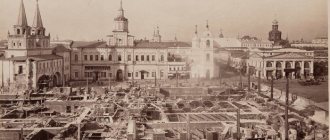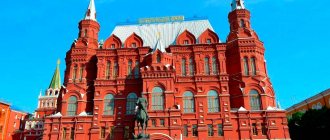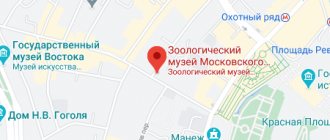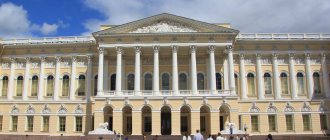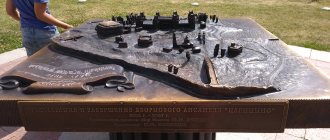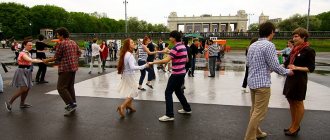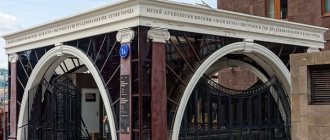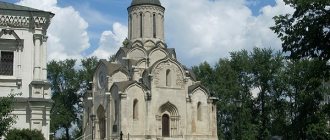Moscow Defense Museum (Moscow, Russia) - exhibitions, opening hours, address, telephone numbers, official website.
- May tours
to Russia - Last minute tours
to Russia
The defense of Moscow 1941-1942, also known as the Battle of Moscow, is one of the turning points of the Great Patriotic War. The battle was exceptional in its significance - here Nazi Germany was dealt a serious blow for the first time, from which it did not immediately recover.
The Moscow Defense Museum, built in 1979 in memory of the heroism of the city’s defenders, is dedicated to this gloomy but very important event.
The first months of the war (Hall No. 1 of the Moscow Defense Museum)
On June 22, 1941, Germany, violating the Non-Aggression Pact of 1939, attacked the USSR. In accordance with the Barbarossa military plan, the USSR was to be captured as soon as possible. Also, the destruction of Moscow, which was entrusted to the German Army Group Center, was supposed to take place “with lightning speed” (“Blitzkrieg”).
In this hall, visitors will be able to imagine life in Moscow during the critical periods of the outbreak of the war. Mass rallies in factories and plants, the mobilization of the male population, the creation of the State Defense Committee, the evacuation of large enterprises and the population from Moscow - all this indicated that the peaceful capital was gradually turning into a center of popular struggle and the mobilization of all kinds of forces to give a worthy rebuff to the enemy.
A particularly striking manifestation of the patriotism of Muscovites was the formation of twelve militia divisions.
In this exhibition, visitors will learn about the difficulties of evacuation, the fate of wartime children, the horrors of German captivity, how the capital's plants and factories were transferred to the production of military products, about Moscow women, students and high school students who were involved in construction Rzhevsko-Vyazemskaya and Mozhaisk defense lines.
Defense of Moscow from enemy aircraft (Hall No. 2 of the Moscow Defense Museum)
The second hall will tell visitors about how the capital was defended from fascist air raids. The exhibition displays a variety of air defense systems.
Hitler, together with his generals, planned to completely destroy the city through bombing, for which the most modern German bombers were brought in.
To protect the capital from fascist air raids, the Moscow Air Defense was created, which consisted of aviation, anti-aircraft artillery, surveillance, warning and communications services
Air raid warning. Hall 2
Walking into the second hall, you can see and feel all the horrors when bombs began to fall from the peaceful sky, and there was practically nowhere to escape from them. But somehow we had to defend ourselves. Soviet designers came up with many air defense installations that were used to defend the capital.
Everything that was used for defense against German aircraft is shown by the State Defense Museum of Moscow. At that time, the city had an air raid warning service. The artillery powerfully resisted enemy aircraft. And the Soviet pilots successfully rushed into the very lair of the enemy.
Heroic defense of Moscow (Hall No. 3 of the Moscow Defense Museum)
The exposition of the hall will tell about the period of the defense of Moscow, how the threat to the capital from fascist troops grew and what actions were carried out by state, party and military bodies to strengthen the city’s defense and strengthen the resistance of troops before the onslaught of the enemy.
Here visitors will learn about the feat of the defenders of the capital during the most difficult and dangerous period of the battle for Moscow for the city. The exhibition presents the plan to capture the city, codenamed “Operation Typhoon,” and how it was carried out. In accordance with the plan, the rapid defeat of the Soviet troops defending the capital, the encirclement of Moscow and the invasion of German troops into the city were envisaged. It was with the capture of Moscow that the leadership of Nazi Germany linked its victory over the USSR.
Visitors will learn why Soviet troops were defeated in early October 1941, and how it affected the subsequent defense of Moscow. As a result of the defeat, the roads to the capital were open, which made it possible for German tank and motorized divisions to reach the outskirts of the city. Perhaps this was one of the most dangerous and dramatic periods of the defense of Moscow. Despite the powerful blows of the German troops, they were unable to break the spirit of the capital’s defenders.
The materials presented in the hall will tell about the unprecedented courage of Podolsk cadets, who, like cadets from other military schools, heroically stood against the numerically superior forces of the enemy army.
History of creation
The Moscow Defense Museum was founded on December 25, 1979 on a historical site: defensive lines were located here in 1941. The museum began with an exhibition dedicated to the 40th anniversary of the Battle of Moscow, which presented documents and weapons from 1941-1942.
Since 1981, the museum has been open to visitors. The permanent exhibition was created in 1995 and dedicated to the 50th anniversary of the Victory.
The Moscow Defense Museum occupies the lower two floors of a five-story building built for the administration of the Moscow Olympic Games in 1980. At the entrance to the museum there is an area with an exhibition of military equipment, which displays the best examples of artillery pieces from the period of the Great Patriotic War.
The museum organizes thematic exhibitions, holds annual military-historical holidays and is a participant in citywide cultural events. Visitors are offered excursions, cultural and educational programs, lectures and excursion support to battle sites in the Moscow region.
Counter-offensive (Hall No. 4 of the Moscow Defense Museum)
The fourth hall is dedicated to the counter-offensive of the Soviet troops, one of the most outstanding events of the Battle of Moscow. This counteroffensive ended with the defeat of the enemy army near Moscow. Here the visitor will be able to get acquainted with the preparations for the counter-offensive, with the difficulties that arose that had to be overcome both at the beginning and during the operation.
In this room you can read the assessments of the significance of the Battle of Moscow for the outcome of the war, which were expressed by the leaders of the allied states and famous military leaders.
The Red Army's counteroffensive began when Soviet troops repulsed another German attempt to break through to Moscow. Based on combat experience, G.K. Zhukov, commander of the Western Front, took the initiative to immediately launch a counteroffensive. As a result of a successful offensive, the enemy army was defeated and driven back from Moscow. The result of the Battle of Moscow indicates that the German High Command lost its “Blitzkrieg” against the USSR.
Due to the limited exhibition space, the museum presents only individual events, operations, fragments and episodes that will allow the visitor to feel the nature and strength of the counter-offensive.
Museum activities
In addition to systematizing, studying and replenishing exhibits, the museum holds scientific and practical conferences and presentations of published literature. The museum also organizes interactive cultural and educational programs, starting in elementary school:
- Tanks of the Moscow Battle - about the achievements of domestic designers, the exploits of Soviet tank crews and the nature of tank battles. Students will see large-scale replicas of tanks, authentic parts, crew in full uniform, anti-tank weapons and defensive structures, and will also be able to try on elements of tank crew uniforms and learn to identify the types of Soviet and German tanks.
- Front behind the front line - the program introduces museum visitors to such a well-known but little-studied topic from the history of the Great Patriotic War as the partisan movement, which played an important role in the victory over the enemy.
- Air defense of the capital during the Battle of Moscow 1941-1942. - the program is dedicated to the blackout of Moscow, the heroes of Moscow's air defense - searchlight operators, balloon pilots, pilots and anti-aircraft gunners, as well as the exploits of ordinary Muscovites in saving their native capital from fires and destruction.
- Weapons of the defenders of Moscow - gives an idea of the most common types of small arms of the Red Army and the Wehrmacht during the Battle of Moscow.
Since 2021, the Moscow State Defense Museum has been taking part in the joint project of the Department of Culture and the Department of Education of the city of Moscow “Study Day at the Museum”:
- Story. Lesson in the museum “1941: the birth of Victory?” - the lesson is based on students’ research activities in the form of group practical work with museum objects.
- Mathematics. Lesson at the Museum "Circular Defense" - the study of the material of the subject "Geometry" takes place against the historical background of the defense of Moscow from enemy air raids during the Great Patriotic War.
- Social science. Lesson in the museum “If the homeland is in danger, then everyone should go to the front...” - the source of knowledge is museum objects related to the history of mobilization at the beginning of the Second World War and the formation of the Moscow people's militia, as well as exhibits telling about heroic soldiers and their exploits.
- Chemistry. Lesson in the museum “Metals in War” - during a lesson in the museum, students will receive practical application of their knowledge on the topic “General properties of metals” and additional knowledge on the history of the Fatherland.
The museum periodically hosts exhibitions, meetings with participants of the Second World War, and commemorates the memorable dates of the Moscow Battle. The museum organizes bus tours to memorable places in the capital and battles in the Moscow region, as well as visiting lectures, which are accompanied by film screenings.
Victory (Hall No. 5 of the Moscow Defense Museum)
The exposition of hall No. 5 is located on two levels. The materials collected here will tell museum visitors about further military routes of formations from Moscow to Berlin. Here are photographs of victorious soldiers, photographs of liberated cities, drawings by front-line artists - everything that is associated with unforgettable moments of the war and front-line life.
Further in the hall there are satirical posters on display - “TASS Windows”, which were posted in the city center and, thereby, raised the spirit of Muscovites. Famous artists and poets took part in the creation of posters.
On the descent to the lower tier there is a Memorial Wall of Glory, on which the names of Heroes of the Soviet Union and the Russian Federation are inscribed. Also presented here are the banners of the guards divisions that marched from Moscow to Berlin, and photographs of the Victory Parade of June 24, 1945.
